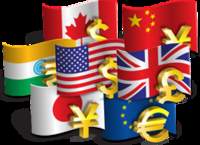Critics Choice Vacations
A bit about exchange rates....from a reader.....

Exchange Rates - How Do They Work?
One of the simultaneously most exciting and most frustrating things about visiting another country is the currency exchange. Foreign money is one thing which can really cement the sense of exoticism which comes from travelling abroad – but exchanging money can also be a fraught and complex process. Why do the amounts differ from currency to currency? Why do the exchange rates fluctuate so much? Are you getting a good deal? It’s confusing. In order to iron out some of these confusions, here is a quick guide to exchange rates and how they work.
What Is An Exchange Rate?
Put very simply, an exchange rate is what one currency is worth compared to another. For example, at the time of writing, £1 is worth $1.52, so a British person heading to the United States could buy $15.19 for £10 British pounds. Both the pound and the dollar are reasonably strong currencies
– exchanging a stronger currency for a weaker one can result in quite a large net increase of wealth as you travel. People who started with strong currencies like pounds or dollars may feel tremendously wealthy as they splash the cash in nations with weaker currencies – but everything usually irons out when the depressing moment comes for you to change you currency back and head home. Passing, say, ₹500 over the counter
and getting $7.56 back is one of the more sobering realities of heading home from a spot of globetrotting!
How Do Exchange Rates Work?
Exchange rates work a lot like stock markets
– the difference being that people are buying currencies rather than stocks and shares in companies. The more people who want to buy and trade in a currency, the more that currency becomes worth. Most of us only buy currency when travelling abroad, but on the international trading scene, currency exchange means big money – and potentially big economic fluctuations. An American company expanding into Germany, for example, will want to buy a lot of Euros in order to make their operation go smoothly. If a lot of American companies do this, the value of the Euro rises enormously. Given that money is flying back and forth across the world all the time, and changing currency as it does so, it is hardly surprising that the exchange rates fluctuate as much as they do. Currencies are measured in two manners – floating systems and pegged systems. The former is usually used by stronger currencies, while weaker currencies favour the latter.
Floating Systems
If a currency is measured as a ‘floating system’, it is measured in its own right and on its own merit. It is essentially a freelance currency, judged purely upon its own performance and unattached to any other currency. In general, larger, stronger currencies which are robust enough to stand alone use floating systems – but the number of ‘free-floating’ currencies is increasing. Using a floating system can be risky, as it subjects your currency to potentially quite wild swings and fluctuations. However, stronger currencies like the British pound and the Kuwaiti Dinar
are generally big enough, solid enough, and stable enough to hold their ground in the storms of the international currency market.
Pegged Systems
Pegged systems lend a nation a measure of stability to their economy, but at the price of a degree of economic independence and the ability to effectively assert their own stamp upon their economy. A pegged economy takes another, stronger currency as its guideline, and ensures that its currency is always worth what the stronger currency is worth. The Nafka of Eritrea, for example, is pegged against the dollar – $1 should theoretically always be worth 1 Nafka. In practice, it never works quite that simply, but in general the weaker currency will usually be pretty close to the currency of the nation against which it is pegged. Pegging a currency is useful in that it lends a certain stability, and can help to stabilize economies in times of turmoil. However, it also requires a lot of bank reserves to keep the currency up to speed with its marker, and can prevent economic growth – as well as giving the nation with the marker currency the ability to effectively control the economic performance of the currencies pegged to it.
Thank you Sally Dawson for your time in writing an article.

Like so many other parents this Fall, my husband and I became “Empty Nesters”. Our baby girl, and youngest of three was heading off to college and we were faced with the reality of being alone for the first time in 26 years. We decided that this was a life milestone that we should observe, rather than dread. We had spent years devoting endless time and energy to our children and now they were all out in the world as healthy, happy, productive members of society. We had much to celebrate. So, after dropping our daughter off at college we traveled to Montana’s Paradise Valley and spent a few days at Sage Lodge to mark this special occasion. Montana’s Paradise Valley starts near Livingston, which sits on I-90, and stretches south along highway 89 towards Yellowstone National Park. It is the major river valley of the Yellowstone River and is flanked by the Gallatin and Absaroka Ranges. Highway 89 was the original entrance into Yellowstone National Park, although there are now two additional entrances, one each in Montana and Wyoming. Along with its unmatched beauty and world-class fly fishing on the river, the valley also offers other natural wonders such as several natural hot springs.

Ernest Hemingway once described Switzerland as “a small, steep country, much more up and down than sideways, and stuck all over with large brown hotels built on the cuckoo clock style of architecture.” Susan’s recent travels between Geneva and Zurich proves that a lot has changed in the Swiss hotel scene since Hemingway’s observation. While she has lots of experience setting up pre- and post-river cruise activities and private trips in the area, this “self-imposed” familiarization was to acquaint herself with Virtuoso’s Swiss properties. Susan’s excited to share her thoughts on this diverse list of hotels, as well as the historic cities they call home.

This past fall, Susan was invited to sit on the Advisory Board for the German National Tourism Offices out of New York City. In partnership to boost tourism to Germany, she toured two of the country’s most iconic cities. From the eclectic coffee and artistic scenes of Hamburg, to an exploration of the tumultuous history of Berlin, there was a lot to take in. Susan hopes her journey will shed light on why Germany should be the destination of your next European vacation. Below you’ll find some incredible places to stay, cuisine to sample, and experiences that will put the discovery of German culture at the forefront of your travels.

With Paris and Rome, London forms the trifecta of must-visit cities for those first taking the dive into European culture. A hub of history, politics, architecture (both very old and very new), and the arts, London has a little bit to offer everyone. This November, Susan had the opportunity to tour over a dozen of the city’s best boutique hotels so you know where to stay during your visit. In addition, Susan also toured some of the charming villages that surround London that are perfect for a day trip, or quick weekend, to escape the hustle and bustle of the city. She hopes her exploration of this British metropolis will help you know where to start when planning your first (or next) European getaway.

